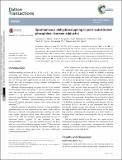Spontaneous dehydrocoupling in peri-substituted phosphine-borane adducts
Abstract
Bis(borane) adducts Acenap(PiPr2·BH3)(PRH·BH3) (Acenap = acenaphthene-5,6-diyl; 4a, R = Ph; 4b, R = ferrocenyl, Fc; 4c, R = H) were synthesised by the reaction of excess H3B·SMe2 with either phosphino-phosphonium salts [Acenap(PiPr2)(PR)]+Cl− (1a, R = Ph; 1b, R = Fc), or bis(phosphine) Acenap(PiPr2)(PH2) (3). Bis(borane) adducts 4a–c were found to undergo dihydrogen elimination at room temperature, this spontaneous catalyst-free phosphine-borane dehydrocoupling yields BH2 bridged species Acenap(PiPr2)(µ-BH2)(PR·BH3) (5a, R = Ph; 5b, R = Fc; 5c, R = H). Thermolysis of 5c results in loss of the terminal borane moiety to afford Acenap(PiPr2)(µ-BH2)(PH) (14). Single crystal X-ray structures of 3, 4b and 5a–c are reported.
Citation
Taylor , L J , Surgenor , B A , Wawrzyniak , P , Ray , M J , Cordes , D B , Slawin , A M Z & Kilian , P 2016 , ' Spontaneous dehydrocoupling in peri -substituted phosphine-borane adducts ' , Dalton Transactions , vol. 45 , no. 5 , pp. 1976-1986 . https://doi.org/10.1039/C5DT02539G
Publication
Dalton Transactions
Status
Peer reviewed
ISSN
1477-9226Type
Journal article
Description
This work was financially supported by the EPSRC and COST action CM1302 SIPs.Collections
Items in the St Andrews Research Repository are protected by copyright, with all rights reserved, unless otherwise indicated.

